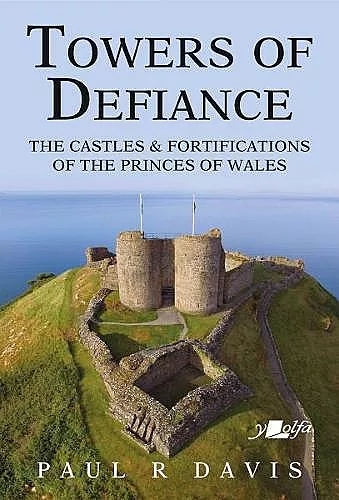Towers of Defiance - Castles and Fortifications of the Princes of Wales
Format:Paperback
Publisher:Y Lolfa
Published:6th Jul '21
Should be back in stock very soon

An extremely comprehensive, fully illustrated guide to the history and evolution of the castle under Wales' native rulers (c.1066-1283). Spectacular aerial photography, plans and reconstruction drawings examine the various architectural designs and layouts that created the distinctive form of the Welsh castle.
This handsome, elaborate volume is a comprehensive, fully illustrated guide to the history and evolution of the castle mainly under Wales’ native rulers (c. 1066–1283). The author, a professional surveyor and a former member of staff of the Dyfed Archaeological Trust, has been researching intensively the history of Welsh castles ever since the 1980s, and among his twelve published works on the historic monuments of Wales and the border areas is his previous volume, Castles of the Welsh Princes (Y Lolfa, 2007). The present authoritative volume is a much-expanded version of the 2007 study and takes full account of the intensive research undertaken on the ground and a full re-consideration of earlier work completed over the last fifteen years or so. The author estimates that at least 500 castles existed in mediaeval Wales, and the total may well have been as high as 700. Indeed, one of the greatest strengths of the work is its amalgam of rigorous academic research and exhausting fieldwork. The study is neatly and sensibly divided into three complimentary parts. The first provides a concise, scholarly overview of the political history of Wales from the dark ages, through to the Anglo-Welsh wars of the thirteenth century during the frenzied reigns of Henry III and Edward I, the Edwardian conquest of 1282 and the political settlement imposed thereafter. Some attention is given to the revolts of the post-Conquest period, notably the Owain Glyndŵr rebellion which broke out in 1400. There is firm evidence of the inclusion of the latest historical research throughout this section of the book, with its helpful endnote references. There follows a briefer introduction to the architectural features of the Welsh castles. The various categories of wooden castles are considered first, primarily the well-known, distinctive motte-and-bailey castles introduced by the Norman invaders from the late eleventh century. A particular problem arises when trying to identify the builders of these early structures which were inevitably vulnerable to fire, and their lifespan was of necessity relatively short. From about 1200 onwards the use of stone was thus becoming more commonplace, but the castles still pose real problems of dating, especially those constructed prior to the 1282 conquest. Much detailed information is included here on the methods of castle construction, the typical characteristics of these towering edifices, and the potential considerable costs involved – under severely restrictive mediaeval conditions and the relative penury of the native Welsh princes (compared with the resources then available to the English crown). Attention is given to the wide array of uses and functions of the typical mediaeval castle. It was, of course, a tangible symbol of the authority and prestige of each individual prince or marcher lord. Military campaigns were often organised and executed from them. In more peaceful times the castle was a place of residence and the centre of administration for the management of the surrounding estate, where taxes and tolls might conveniently be levied and collected. They could also serve as a judicial centre and often a convenient prison house. The history of each individual castle was certainly different, but in almost all cases their military and defensive functions assumed the highest priority rather than the aesthetic features which became much more significant to later generations from the Tudor period onwards. Part 3 of the book comprises a helpful and detailed gazetteer of the castles built by the three most prominent royal dynasties of the pre-1282 period, notably Gwynedd, Powys and Deheubarth. These are followed by a list of those castles for which the minor royal lines in Wales were responsible. Each entry in this section comprises a helpful history of the edifice in question and its background, outlines the features of each castle which are still standing today, and provides details for the present-day traveller of how to reach each individual castle. In many cases, the castles of yesteryear survive, if at all, only as overgrown earthworks. Many of these edifices remained a vital part of mediaeval life until at least the fifteenth century when they were superseded by more modern structures more suitable for modern methods of waging war. The rich array of sources used by the author are noted at the foot of each entry. And some superb photographs, many of these aerial, plans and sketches are also included throughout this part of the study and help us to examine in depth the various architectural designs and layouts that created the distinctive form of the pre-1282 Welsh castle. There are also a number of maps prepared for this study. Helpful features of the work include simplified family trees of each of the three main royal dynasties in pre-1282 Wales, a note on the complex field of Welsh heraldry, and a large number of helpful suggestions for further reading in this fascinating field. -- J. Graham Jones @ www.gwales.com
ISBN: 9781912631308
Dimensions: 249mm x 169mm x 22mm
Weight: unknown
378 pages